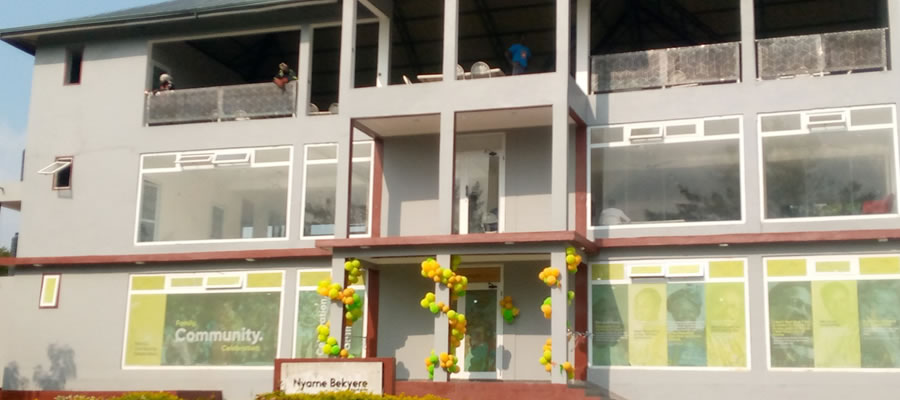
Educational status in the region is discussed with respect to various population subgroups- district, sex, locality and economic characteristics. These provide the basis for policies that seeks to target specific subgroups of the population. Moreover, inequalities in educational attainment can be observed better when data is disaggregated by different backgrounds.
Educational Status in the Districts
On the average, 20 percent of all persons aged 15 years and older have never attended school in the Eastern Region. The majority (59.8%) have primary or JSS/JHS/Middle school education with less than 10 percent having senior secondary/high education and negligent proportions have vocational technical, post-secondary and higher education.
Disparities in educational attainment exist among the districts. In the New Juaben Municipal where the regional capital is located and rate of urbanization is highest, 9.8 percent have no education. The rates for the least urbanized districts are far higher, some reaching more than twice that of the more urbanized districts, for example, the rate for Kwahu Afram Plains North (44.6%) and Upper Manya Krobo, (37.5%). A few other districts have higher proportions with no education than the district average.
The differences in the proportions that have primary and JSS/JHS/Middle education are not as large as those for other levels of education. At least a little more than a quarter have attained these JSS/JHS/Middle levels of education in all the districts. This is an indication of the almost universal access to primary and JSS/JHS/Middle school education. Secondary and higher education are not accessible physically and financially to most communities, particularly the poor and rural. Only three districts (Akuapim South, 10.8%; New Juaben South, 12.2% and Lower Manya Krobo, 10.6%) have more than one tenth of their population aged 15 years and older with SSS/SHS and higher education.
Consequently, the average for the entire region (7.6%) is far lower than those of the three districts. The differences in the proportions that have attained the other levels of education are explained by the rate of urbanization, For example, New Juaben South recorded the highest percentage of those who have post secondary education. All the municipalities, including New Juaben North and South Municipalities, have higher proportions with secondary or higher education. It must be noted, however, that rural-urban migration of secondary and university graduates also accounts for the larger proportions of those with secondary and higher education in the more urbanized districts.
Educational Status by Sex
There are wide gaps between the educational status of the males and females which shows school attendance among the population aged 3+ years. The percentage is females almost twice the percentage of the males who have never attended school. On the other hand, higher proportions of the males than the females have post-secondary and higher education. Between the sexes, very negligible differences are observed regarding the proportion that has primary education and (pre-school education).
Level of Education and Type of Employment for Persons 15 years and Older
Overall, more than 9 out of every 10 (95.3%) of the employed population in the Eastern Region are in four categories - employees (15.1%), self-employed without employees (68.4%), self-employed with employees (4.0%) and contributing to family labour (7.8%). The majority (80.3%) of those who have no education are the self-employed without employees and contributing to family labour (9.6%). These categories of the employed also constitute the highest proportion of all the employed in the Eastern Region. In Ghana, self-employed without employees and those contributing to family labour are usually famers (producing cash and food crops) or those working in the informal sector.
The self-employed without employees in particular have low skills and they form the bulk of the agricultural sector, the backbone of the economy. Agricultural activity is important in the Eastern Region (as discussed in chapter 11) but most famers are self-employed and have low levels of education. This largely accounts for the moderate achievement of modernization of the agricultural sector.
Those with basic education (JSS/JHS/Middle) are mostly self-employed with employees while those with secondary and higher education are mostly employees. Approximately, a third of secondary and vocational/technical/commercial graduates are employees. This category of educational subgroup also recorded the highest percentage of those who are self-employed with employees. Almost all persons with higher education in the region are employees (90.3%). There has been shrinking employment opportunity in the public sector where those with higher education usually seek for jobs. Overall, the majority of those with less than secondary education or none at all are self-employed without employees while those with post-secondary education and above are employees.
Level of Education and Employment Status by Sex
The same patterns of educational status by employment types are observed among both males and females. Slight differentials, however, exist between the sexes with regard to the percentages of various educational categories with the different types of employment.
Majority of those with little or no education are self-employed. But a slightly higher percentage of the females (81.4%) than the males (78.4%) with no education are self-employed without employees, Almost 10 percent of the females with no education compared with 6 percent of the males are contributing to family labour. But a slightly higher percentage of the males (4.6%) with similar educational status are self-employed with employees compared with (3.5%) of their female counterparts. A higher percentage of the females with basic education (76.2%) and secondary education (50.6%) are self-employed without employees compared with males with similar educational status who recorded 67.6 percent and 45.4 percent respectively for those with basic and secondary education.
A higher proportion of the females than the males with basic and secondary education also are contributing to family labour but about the same percentage of both males and females with post-secondary education are doing the same. A higher percentage of the males (35%) than the females (27%) with vocational/technical/commercial education are employees while almost twice the percentage of the females (4.1%) compared to the males (2.1%) are contributing to family labour. Among those with higher education, a higher proportion of the females (93%) than the males (89%) are employees while higher percentage of males (5.5%) with higher education than female (4.3%) are self-employed without employee.
Level of Education and Occupation
The results of the analysis of the educational status by occupation show that, on the average, three types of occupation constitute the major occupations in the Eastern Region: those who are skilled agricultural, forestry and fishery workers (45.2%) recorded the highest percentage, followed by service and sales workers (19.3%) and crafts and related trades workers (15.2%). The distribution of occupation by level of education shows that these three types of occupation are the occupations of the majority of those with no education and all the other categories up to vocational/technical/commercial level. The percentages range from 63.6 percent among secondary education to 91.7 percent among those who have never attended school. Those with post-secondary education or higher are mostly professionals.
Level of Education and Occupation by Sex
The distribution of occupation by level of education among the sexes shows that skilled agricultural, forestry and fishery workers, service and sales workers and crafts and related trades workers constitute the majority of occupation among those with education below secondary school or with no education. Those who have post-secondary and higher levels of education, whether males or females, are professionals. The proportions of the females with secondary education or higher educational status who are professionals are higher than their males. Higher proportions of the females than their male counterparts with secondary and above education or higher belong to the service and sales workers occupational category.
Literacy rate and educational status are generally low in the region. Less than two thirds of the populations on the average are literate. There are wide disparities in illiteracy rate and educational attainment among the districts and the socioeconomic subgroups of the population. The majority of those with low levels of educational attainment are in occupations that do not require high skills. (Overall, those with high levels of education are mostly employees while the less educated are predominantly self-employed without employees.
Date Created : 10/13/2023 12:00:00 AM












 facebook
facebook
 twitter
twitter
 Youtube
Youtube
 +233 593 831 280
+233 593 831 280 0800 430 430
0800 430 430 GPS: GE-231-4383
GPS: GE-231-4383 info@ghanadistricts.com
info@ghanadistricts.com Box GP1044, Accra, Ghana
Box GP1044, Accra, Ghana